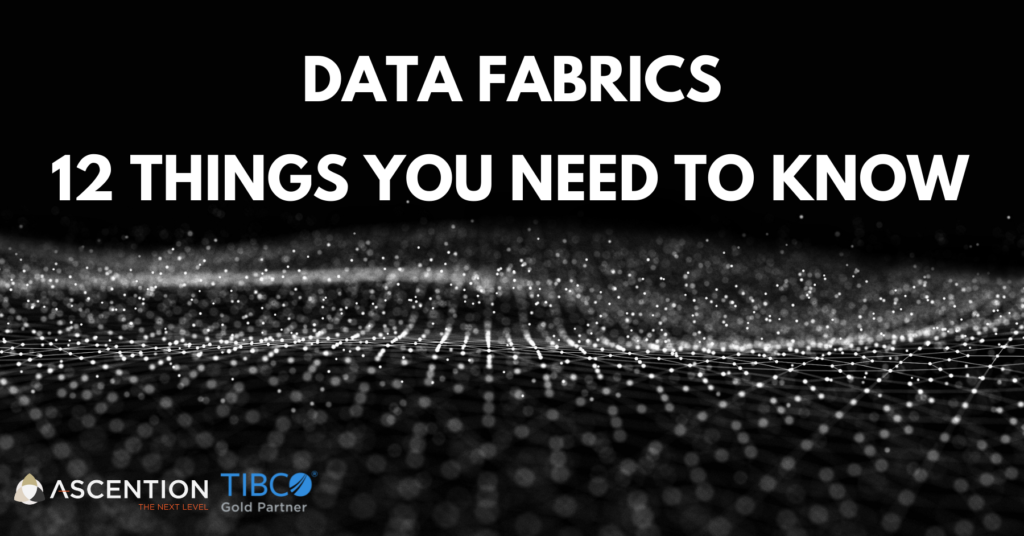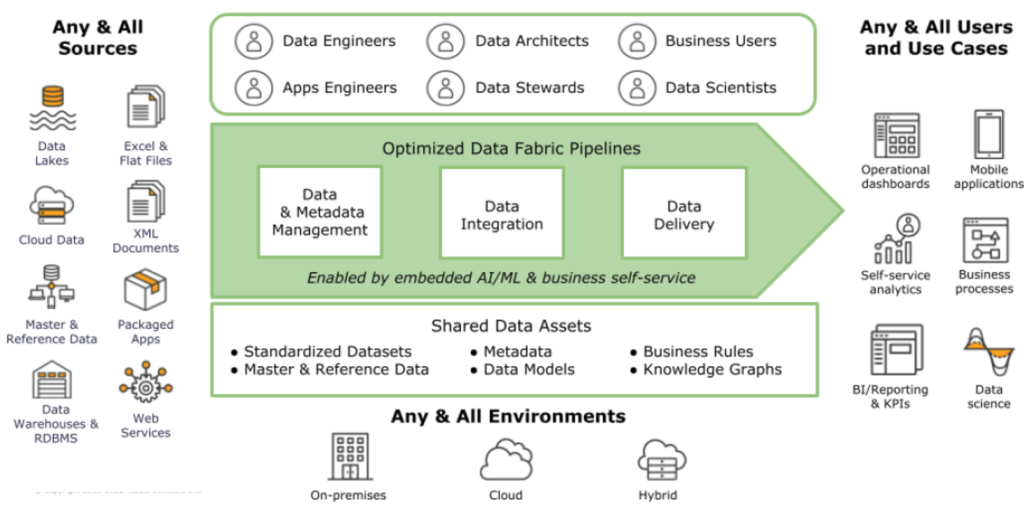12 Things You Need to Know About Data Fabrics
More data sources, more silos, more complexity, and constant change. Data architectures are challenged to keep pace, creating a big problem for today’s data-driven organizations—one that puts your business at risk.
In response, data-driven organizations are implementing data fabrics. One of the hottest analyst and vendor terms in data management today, data fabrics are among data and analytics fastest-growing trends.
This paper includes 12 things you need to know about data fabrics to benefit from them at your organization.
1. Why are organizations interested in data fabrics?
Data is your fuel for digital transformation. But with more data sources, more silos, more complexity, and constant change, your data management processes and architectures are challenged to keep pace—a big problem for data-driven organizations that puts your business at risk.
A data fabric is a response to today’s highly distributed and diverse data silos that have overstretched current data management, integration, and delivery processes, and broken traditional data architectures.
Data fabrics are designed to help address:
- Highly distributed, difficult-to-access, poorly integrated business data that leads to poor business decisions, reduces customer satisfaction, and slows innovation and
- Business users’ demand for greater data trustworthiness and more self-service despite growing data
- Real-time data’s new business opportunities that challenge existing data management and integration tools and methods.
- Growing data compliance and privacy regulations that require greater data governance and
- To become more data-driven, organizations are adopting data fabrics to:
- Modernize data architecture to take advantage of the latest
- Provide the data that fuels transformative engagement, enhanced operations, and innovative
- Optimize data management, integration, and delivery processes and
- Do all of the above in a unified yet flexible
2. What is a data fabric?
A data fabric is a modern distributed data architecture that includes shared data assets and optimized data fabric pipelines that you can use to address today’s data challenges in a unified way.
3. Is a data fabric a product, a solution, an architecture, or what?
Despite what many vendors might claim, a data fabric is not a single product or specific platform that you can simply buy and deploy within your existing data architecture. It includes a common distributed architecture, shared data assets, and optimized data fabric pipelines that incorporate a converged set of data and metadata management, data integration, and data delivery capabilities.
4. What data, sources, and use cases are supported within a data fabric?
A data fabric supports:
- Data for All Users and Use Cases: Provides timely, consistent, and trusted data for your wide range of analytic, operational, and governance use cases, as well as business self-service
- Data from Any and All Sources: Accesses, combines, and transforms both in-motion and at-rest data from across your diverse, distributed data landscape using metadata, models and
- Data that Spans Any Environment: Flexibly spans your distributed on-premises, hybrid, and multi-cloud
5. How is a data fabric different from other data architectures?
Data fabrics embrace today’s more distributed data landscapes and take advantage of more modernized data management and integration capabilities so you can:
- Support More Use Cases: One virtual place to go for analytic, operational, governance, and self-service
- Span More Data Types and Methods: Data-in-motion and data-at-rest from on-premises, cloud, Internet of Things (IoT) devices, and third-party sources.
- Better Optimize Data Fabric Pipelines: Your data fabric pipelines include an optimized combination of intelligent, converged data and metadata management, integration and delivery
- Provide Greater Deployment Flexibility: Your data fabric can deploy flexibly in phases across your distributed on-premises, hybrid, and multi-cloud environments.
6. What is a data fabric not?
- It is not a single product: A data fabric combines an integrated collection of data management and data integration capabilities, as well as shared data assets, deployed to support a distributed data
- It is not just architecture: A data fabric certainly requires a distributed data architecture at its But it also requires optimized data management processes and ultimately your most valuable shared data assets.
- It is not a rip and replace effort: Data fabrics augment current data landscapes and fill data management and integration capabilities
- It is not an overnight implementation: Implementing a data fabric can be a multi-year journey that requires new architecture, new technology, new processes, and new
- It is not right for every customer: Some organizations may lack the difficult business challenges and data landscape complexity to benefit from a data
7. What value do you get from a data fabric?
- Fuel Your Data-Driven Business: Support multiple, diverse users and use cases with a modern distributed data architecture, shared data assets, and optimized data management and integration
- Accelerate Value Realization: Accelerate time to value by unlocking your distributed on-premises, cloud, and hybrid cloud data—no matter where it resides—and delivering it at the pace of your
- Empower Your People with Timely, Consistent, and Trusted Data: Democratize data access to arm business users with all the data they need to make faster and more accurate business
- Benefit from Technology Innovation Sooner: Embrace new data and analytics technology advancements such as data science, real-time data, and the cloud faster to stay ahead of your
- Save Time and Money: Streamline data management and integration processes and pipelines via an optimized combination of intelligent, converged data management and integration capabilities that embed AI/ML and business self-service.
- Govern and Comply With Confidence: Ensure proper data governance and control so you can deliver the right data at the right time, securely, and in compliance with your ever-changing regulatory
8. Who uses a data fabric?
- Data Users (data scientists, business analysts, applications developers) use the data fabric to access reusable, business-friendly data views via an easy-to-use catalog and standard application programming interfaces (APIs).
- Data Engineers build and maintain the timely, trusted, reusable data assets shared by users and use
- Data Architects design and evolve the data fabric
- Data Stewards and Business Users manage data quality and consistency while ensuring data
9. What is the state of data fabric architecture adoption?
The data fabric style of data architecture is currently in the early-adopter phase. Gartner places it on the far-left side of the Data Management Hype Cycle1 and estimates it’s between 5-to-10 years from “Plateau of Productivity.” Users are selectively implementing key components such as data virtualization and data catalogs to address current pain points and set the foundation for a more comprehensive implementation.
10. Does TIBCO provide a data fabric?
TIBCO flexibly supports your data fabric implementation with:
- Optimized data and metadata, data integration, and data delivery capabilities so you can intelligently simplify, automate, and accelerate your data fabric
- Shared data assets that support all your users and use
- Flexible distributed data fabric architecture that fits your complex, ever-changing technology
11. What is different about TIBCO’s data fabric approach?
TIBCO is uniquely positioned to help your business and IT teams successfully build your data fabric.
- Converged data & metadata management, data integration, and delivery capabilities: To intelligently simplify, automate, and accelerate your data ingestion, transformation, and provisioning pipelines so you can save time, cut costs, and reduce friction, TIBCO converges data & metadata management, data integration, and data delivery capabilities within one unified platform, enhanced by embedded AI/ML and business self-service. Only TIBCO’s data fabric solution converges:
- Data & Metadata Management
-
- Data & Process Modeling
- Master & Reference Data Management
- Metadata Management
- Data Quality
- Data Governance
- Data Integration
-
- Data Virtualization
- Messaging
- Streaming
- ETL/ELT
- Replication
- Synchronization
- Data Delivery
-
- Data Catalog
- API Management
- Data Preparation
- Security
- Holistic data asset sharing: To ensure your data fabric supports all your users and use cases, TIBCO lets you manage your most valuable, shared data assets holistically. With TIBCO, you no longer need to treat metadata, master data, reference data, business rules, knowledge graphs, as well as your transaction data and streaming data assets, as unique unrelated Being more holistic creates synergies that simplify governance, security, control, and so much more.
- Easier-to-deploy and adapt distributed data fabric architecture: To help you build a data fabric that is right for your complex, ever-changing technology landscape, TIBCO openly supports nearly every option you might This support gives you the flexibility to meet your unique and evolving data fabric needs, without being forced to limit yourself to a particular architecture pattern, cloud supplier, or technology-enabling solution.
12. How do you build a data fabric?
Your unique data fabric implementation journey will have many starting points, interim steps, and destinations. For best success, consider these steps:
- Start with your data fabric vision and
- Prioritize highest-business-impact data fabric
- Perform a data management and integration gap
- Take advantage of data virtualization if you have not already done
- Standardize your approach to shared data
- Organize for agility and
- Prove value, then scale
- Don’t try to go it
Take the Next Step
Now that you know the essentials of a data fabric, how do you proceed? If your next step is to learn more, visit www.tibco.com/solutions/data-fabric.
Ascention Shares Experience
Ascention wishes to impart skills and knowledge. The team at Ascention is always willing to share our experiences to assist your team’s progress – simply contact us to start an informal, no-obligation discussion.
Ascention Contact:
Dan Cox, Chief Executive Officer
E: dan.cox@ascention.com
M: +61 415 612 906
Ascention Data As A Language series
Please see previous topics:
- Supporting Your Data Fabric Journey (blog, 10 minute read)
- How Data Lineage Moves from Red to Black (blog, 5 minute read)
- How Knowing Your Data Inside Out May Save You Billions (blog, 5 minute read)
- The Business Value and Benefits of Master Data Management (blog, 7 minute read)
- Data As A Language (Whitepaper, 7 minute read)
- No, The Stork did NOT bring your Data (blog, 3 minute read)
- Data Governance Foundations (Whitepaper, 10 minute read)
- Ascention named in Gartner 2020 Market Guide for MDM External Service Providers (Research Article, 30 minute read)
- How Data Governance Translates to Superior Customer Experience (Webinar, 60 minute watch)
- Where Unity Delivers Clarity – How MDM & a DeLorean Increases Transparency for your Organisation (Article, 5 minute read)
- What Story is Your Data Saying? (Video blog, 19 minute watch)
1 Feinberg, Donald and Adam Ronthal “Hype Cycle for Data Management, 2019”, Gartner Research, G00369950, https://www.gartner.com/document/3955768 accessed May 2020.match


